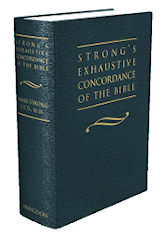Textus Receptus Bibles
What are Strongs Numbers?
Strong’s Numbers are an index of every word in the original biblical manuscript texts. Each Strong's Number links the root meaning of the words of the Bible back to the original meanings in the Hebrew and Greek manuscripts from which they were translated.
 Strong's Numbers come from a reference book known as "Strong's Exhaustive Concordance
of the Bible". A concordance is an alphabetical list of words and definitions
just like a dictionary except they only apply to one book (in our case the King James Bible).
Each word in the concordance is displayed within a single line of text taken from the verses in which
they occur.
Strong's Numbers come from a reference book known as "Strong's Exhaustive Concordance
of the Bible". A concordance is an alphabetical list of words and definitions
just like a dictionary except they only apply to one book (in our case the King James Bible).
Each word in the concordance is displayed within a single line of text taken from the verses in which
they occur.
With a computer now in every home we can search the Bible with ease and with much more flexibility than any printed concordance. As a consequence it would seem that Strong’s Numbers are not as important to our personal study of the Bible as they use to be. However, there is more to Strong's Concordance than just a list of words of the Bible.
The English language is complex in as much as a single word can have several different meanings. Strong's Concordance shows us which of those meanings is correct. This is why the use of Strong’s Numbers is still important when referring to scholarly works and in theological discussions. The Strong’s numbering system is used in works by many other writers as a theological standard.
In any study of the Bible Strong’s Numbers help us to achieve the following:
- an understanding of the intended meaning of a word
- to easily find Bible words in their proper context
- compare different usages of the same word
- analyse keywords
- analyse word frequencies
- find and analyse phrases and idioms
A Short History of Strong’s Numbers
Strong's Exhaustive Concordance was created by Dr. James Strong an American biblical scholar. He was also an educator and the Professor of Biblical Literature at Troy University (New York) in 1858-61 and Professor of Exegetical Theology at Drew Theological Seminary in 1868. The Strong’s Exhaustive Concordance of the Bible was first published in 1890 and revised editions are still in print today.
Professor Strong had over a hundred people working on this project who diligently listed every occurrence of every word in the KJV. For over a hundred years now, when someone wanted to find a verse in the Bible, the fastest way to do it was with a Strong's Concordance. No printed Bible study library was ever considered complete without a Strong's listing.
The Intended Use of Strong’s Numbers
Strong's Concordance is not a translation of the Bible nor is it intended as a translation tool. The use of Strong's numbers is not a substitute for professional translation of the Bible from Hebrew and Greek into English by those with formal training in ancient languages and the literature of the cultures in which the Bible was written.
Since Strong's Concordance identifies the original words in Hebrew and Greek, Strong's Numbers are sometimes misinterpreted by those without adequate training to change the Bible from its accurate meaning simply by taking the words out of cultural context. The use of Strong's numbers does not consider figures of speech, metaphors, idioms, common phrases, cultural references, references to historical events, or alternate meanings used by those of the time period to express their thoughts in their own language at the time. Professionals and amateurs alike must consult a number of contextual tools to reconstruct these cultural backgrounds.
Many scholarly Greek and Hebrew Lexicons (e.g., Brown-Driver-Briggs Hebrew Lexicon, Thayer's Greek Dictionary, and Vine's Bible Dictionary) also use Strong's numbers for cross-referencing, encouraging a consistent approach to study.
